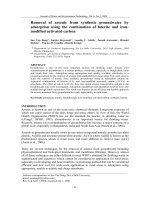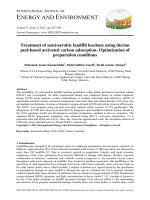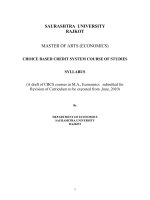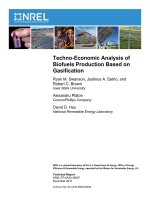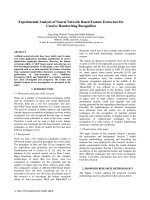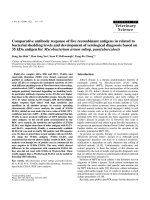Optimisation of durian peel based activated carbon preparation conditions for dye removal
Bạn đang xem bản rút gọn của tài liệu. Xem và tải ngay bản đầy đủ của tài liệu tại đây (577 KB, 10 trang )
SCIENCE & TECHNOLOGY DEVELOPMENT, Vol 16, No.M1- 2013
Optimisation of durian peel based
activated carbon preparation conditions for
dye removal
•
Le Thi Kim Phung
University of Technology, VNU-HCM
•
Le Anh Kien
Institute for Tropical Technology and Environmental Protection, Vietnam
(Manuscript Received on January 21st, 2013, Manuscript Revised July 06th, 2013)
ABSTRACT:
Agricultural wastes are considered to be
a very important feedstock for activated
carbon production as they are renewable
sources and low cost materials. This study
present
the optimize
conditions
for
preparation of durian peel activated carbon
(DPAC) for removal of methylene blue (MB)
from synthetic effluents. The effects of
carbonization temperature (from 673K to
923K) and impregnation ratio (from 0.2 to
1.0) with potassium hydroxide KOH on the
yield, surface area and the dye adsorbed
capacity of the activated carbons were
investigated. The dye removal capacity was
evaluated
with
methylene
blue.
In
comparison with the commercial grade
carbons, the activated carbons from durian
peel showed considerably higher surface
area especially in the suitable temperate and
impregnation ratio of activated carbon
production. Methylene blue removal capacity
appeared to be comparable to commercial
products; it shows the potential of durian peel
as a biomass source to produce adsorbents
for waste water treatment and other
application.
Optimize
condition
for
preparation of DPAC determined by using
response surface methodology was at
temperature
760 K and IR 1.0 which
resulted the yield (51%), surface area (786
m2/g), and MB removal (172 mg/g).
Keywords: Water treatment, durian shell, activated carbons, adsorption, surface area.
1. INTRODUCTION
Water contamination by dye is a major
concern for wastewater treatment, especially
industrial wastewater such as textile, leather,
paper, plastics [1] It is predicted that more than
100,000 commercially available dyes with over
7×105 tones of dyestuff produced annually [2].
To remove dyes from wastewater, one of the
Trang 22
most effective techniques is adsorption by
activated carbon. However, owing to its
expensive price, the use of activated carbon for
removal of color from wastewater is limited. For
the aim of reducing wastewater treatment costs,
therefore, the development of activated carbon
TAẽP CH PHAT TRIEN KH&CN, TAP 16, SO M1- 2013
from no-cost or waste materials acquired locally
is an interesting option.
A large variety source of carbonaceous
materials have been used for the production of
activated carbon such as coal [3, 4], coconut shell
[5], sawdust [6], jute stick [7], corn cob [8],
kenaf [9], rice husk [10]. Durian (Durio
zibethinus Murray) is one of the important
seasonal fruits in tropical Asia. The durian is
distinctive for its large size, unique odor, and
formidable thorn-covered husk. Direct disposal
of durian peel can cause social and
environmental problems since agricultural waste
is already in excess amount and expected to
increase in the future. Therefore several attempts
have been made in order to add more value to
durian peel and one of them is to convert it to
activated carbon. However, there are very few
studies in the production and application of
activated carbon from durian peel.
Activated carbon is generally obtained using
two main steps, e.g. carbonization of the raw
materials below 1000oC in an inert atmosphere
and activation. Activated carbon can be basically
obtained by physical or chemical activation [11].
Activated carbon synthesised from physical
activation has wider pore size distribution and a
more mesoporous structure compared to that
derived from chemical activation [12]. But
chemical activation offers several advantages
because it is carried out in a single step,
combining
carbonization
and
activation,
performed at lower temperature.
In this study, the admixed method of physical
and chemical process to produce activated carbon
derived from durian peel was applied. The
response surface methodology (RSM) was used
for optimization of DPAC preparation parameters
including activation temperature (T) and
impregnation ratio (IR). The response functions
were used to optimize included DPAC yield,
surface area and amount of adsorbed dye.
2. MATERIALS AND METHODS
Preparation of activated carbon
Durian peels were collected from local fruit
stores in Ho Chi Minh city, washed with distilled
water many times in order to remove dust and
other inorganic impurities. After that it was cut
into approximately 1cm x 1cm size and dried at
110oC for 24 h to reduce its moisture content.
The dried durian peels were grounded in hammer
mill and then stored in desiccators to prevent it
from moisture.
Potassium hydroxide (KOH, 94%) used as
chemical impregnation agent were purchased
from SigmaAldrich. For pre-treatment using
chemical activating agent, 50g of dried durian
peel was mixed with KOH solution (50%) with
impregnation determined mass ratio of chemical
activating agent to durian peel in the round bottle
flask (250ml). During the impregnation period,
the mixture was stirred at 200 rpm for 5h at room
temperature (around 27oC). The resulting slurry
was poured onto porcelain disc and dried at
110oC for 24h. The dried product was stored in
desiccators for the carbonization step.
The resulting samples were carbonized in an
electric furnace (Naber Therm, Germany) under
nitrogen atmospheric (800 ml/min) with heating
from room temperature (27oC) until the desired
temperature. The rate of heating was 5oC/min.
Then activation with CO2 (800 ml/min) took
place. Samples were held at desired temperature
for 1 h before cooling down under nitrogen flow
(400 ml/min). Many studies found that the
activation time does not cause significant change
on the activated carbon [13,14]. Therefore, the
activation time was chosen 1h. The samples were
grounded in micro hammer mill until it became
powder (40/60 mesh) and were added to a beaker
and treated with HCl 2M solution for 24 h.
Consecutively, carbon powders were repeatedly
washed with cool distilled water until pH of
Trang 23
SCIENCE & TECHNOLOGY DEVELOPMENT, Vol 16, No.M1- 2013
solution reach 6.5 – 7.0. Then, the samples were
dried at 110oC for 3h and stored in desiccators.
Characterization of activated carbon
V - the volume of the solution (l)
W - the mass of dry adsorbent used (g).
Experimental design
The pore structural analysis of the prepared
activated carbon was carried out by nitrogen
adsorption at 77.3 K using Nova 2200E
(Quantachrome Nova, USA). The Brunauer–
Emmett–Teller (BET) surface area, pore radius
and pore volume of the activated carbons were
determined by application of the Brunauer–
Emmett–Teller and Dubinin–Asthakov (DA)
analysis software available with the instrument,
respectively.
Adsorption equilibrium studies
In this study, the respond surface with central
composite design was utilized to evaluate the
main and interaction effects of the factors:
Activated temperature T (X1) and impregnation
ratio (IR). (X2) on the DPAC yield (Y1) , DPAC
surface area (Y2) and amount of MB adsorbed
into the DPAC (Y3). The complete model is
based on the simultaneous variation of two
factors at two levels with four experiments as the
repeatability of the measurements at the center of
the experimental domain implying the running of
12 trials. All factors and levels tested were
reported in Table 1. The experimental data were
fitted with quadratic order with interactions of
polynomial response surface models, which have
the following form:
Basic dye used in this study was methylene
blue (MB) purchased from Sigma–Aldrich and it
was used as received without further purification.
MB has a chemical formula of C16H18 N3SCl,
with molecular weight of 319.86 g/mol. MB was
chosen in this research because of its wide
application and known strong adsorption into
solids. The batch adsorption experiments were
performed in erlenmeyer flasks (250ml)
containing 4 -12 mg of the prepared activated
carbon and 100 ml of methylene blue solutions
with initial concentrations of 5 mg/l. The
mixture was kept in an isothermal shaker at 270C
for 24h with an agitation speed of 120 rpm. The
concentration of MB dye solution was measured
using a double beam UV–Vis spectrophoto meter
(UV-VIS18-1815-01-0001, England) at 668 nm.
The amount of adsorption at equilibrium, qe
(mg/g), was calculated by:
where C0 - the liquid-phase concentrations of
dye initially (mg/l)
Ce - the liquid-phase concentrations of
at equilibrium (mg/l)
Trang 24
(1)
With i,j=1, 2
Where Y is the estimated response, Xi is the
scaled independent process variable (−1=low
level, 0=central level and +1=high level) and the
coefficients b0, bi, bii, bij characterize respectively
the constant, the linear and quadratic effects of
the variable Xi and the interactions between Xi
and Xj. To define these coefficients, it is required
a star point at two levels in every variable Xi
(+=1.414 and -=-1.414). Regression analysis of
the data was carried out within a statistical design
package (‘Design-Expert’ version 8.0.3, Stat
Ease, Inc,).
TAẽP CH PHAT TRIEN KH&CN, TAP 16, SO M1- 2013
Table 1. Factors and levels tested for the
designed experiment
Z1
Z2
Xi (i=1,2,3) coded variable
T (K)
IR (-)
+1
923
1.0
-1
673
0.2
0
798
0.6
+=1.414
975
1.17
-=-1.414
621
0.03
2.5 Desirability Function
The approach to optimization of multiple
responses is to utilize the simultaneous
optimization technique popularized by Derringer,
G., and Suich, R., [15]. It is one of the most
widely used methods in industry which is based
on the idea that the "quality" of a product or
process that has multiple quality characteristics,
with one of them outside of some "desired"
limits, is completely unacceptable. Their
procedure makes use of desirability functions.
The common approach is to first transform each
response yi into an individual desirability
function di(yi) that varies over the range 0 di(yi)
1, where it takes a range of between 0 and 1, and
increases as the corresponding response value
becomes more desirable.
In this study, the target is Larger Better (LB).
Therefore, the objective is ,
where x is the factors, is parameter estimates
of polynomial regression coefficients obtained by
least square method. The Li is lower acceptable
values of yi, while Ti is target values desired for
ith response, where Li
value of r=1 means that the desirability function
is linear, r>1 means that the desirability function
is convex, more importance should be attached to
close with the target value, and when the shape of
the di(yi) is concave when the value is 0
3. RESULTS AND DISCUSSION
Experimental results
The different formulations of the factorial
design consisted of all possible combinations of
two factors at all levels and were conducted in a
fully randomized order. The face-centered design
was used to evaluate both the main and the
interaction effects of the operating conditions on
the DPAC process. To determine the
experimental error, the experiment at the centre
point was replicated four times on different days.
The matrix of the experiments and the response
results for every experiment are listed in Table 2,
and sorted by standard order (StO) for easier
comparison. The highest amount of the DPAC
yield was 67% obtained at the temperature 621 K
and IR 0.6. Whilst the highest DPAC surface area
and amount of MB adsorbed were 880 m2/g and
225 mg/g and 225, respectively which was
obtained at temperature 798 K and IR 1.2. It
illustrates the complicated affect of operating
condition on the yield and properties of DPAC.
Table 2. Experimental matrix and values of
observed responses
StO
Z1
Z2
Y1
Y2
Y3
1
673
0.2
63.25
553.25
88.25
2
923
0.2
46.32
505.31
83.75
3
673
1.0
57.85
654.51
116.24
4
923
1.0
43.36
680.38
135.18
5
621
0.6
67.25
425.16
71.24
6
975
0.6
41.35
445.75
78.65
7
798
0.0
52.43
750.68
140.31
8
798
1.2
43.12
880.21
225.36
9
798
0.6
46.26
804.35
170.08
10
798
0.6
46.58
815.64
171.21
11
798
0.6
46.83
812.52
170.92
12
798
0.6
45.97
807.24
171.68
Statistical data analysis
Analysis of variance (ANOVA)
For the statistical analysis of experimental
results, center method was used to calculate the
Trang 25
SCIENCE & TECHNOLOGY DEVELOPMENT, Vol 16, No.M1- 2013
estimated coefficients of the polynomial
functions of response surfaces for the DPAC
yield (Y1), DPAC surface area (Y2) and amount
of MB adsorbed into the DPAC (Y3). The
analysis of variance (ANOVA) is presented in
Table 3 for three response functions.
Table 3. ANOVA for response surface quadratic model
R
F
Squared
Value
152
0.984
75
< 0.0001
significant
276732
55346
0.989
112
< 0.0001
significant
24501
4900
0.951
23
0.0007
significant
Model
Sum of Squares
Mean Square
DPAC yield (Y1)
760
DPAC surface area (Y2)
amount of MB adsorbed
(Y3)
The analysis results showed that, three
respond functions with quadratic model were
statistically significant. The values of p-value or
“Prob > F” are < 0.05 at 95% confidence.
Furthermore, the Models F-value of 75, 112, 23
imply the models are significant. The polynomial
Figure 1.a. Predict versus
experimental yield of DPAC
For the production of commercial activated
carbons, relatively high product yields are
expected. The yield of activated carbon depended
on the carbonization temperature of the raw
materials. In addition pre-treatment with different
amount of KOH plays an important role on the
Trang 26
regression models were in good agreement with
the experimental results with the coefficients of
determination from 0.95 to 0.98. The fit of the
empirical models also can be seen clearly the Fig.
1 a,b,c of the predicted value versus the
experimental value of the three functions.
Figure 1.b. Predict versus
experimental surface area of DPAC
Effect of operation conditions on the yield of
activated carbon
p-value Prob > F
Figure 1.c. Predict versus
experimental MB adsorbed
yield of product. Fig. 1a, b, c describes the effect
of carbonization temperature and pre-treatment
with different IR on the yield of activated carbon.
In the response surface methodology, the
effects of factors on the response functions are
determined by the value of coefficient of coded
factor and their significance. The great value of
coefficient illustrates the high effect of the factor
TAẽP CH PHAT TRIEN KH&CN, TAP 16, SO M1- 2013
on the response function and Values of "Prob >
F" less than 0.05 indicate model terms are
significant. These values greater than 0.10
indicate the model terms are not significant. The
value of coefficients of coded and factual factors
of response surfaces yield of active carbon are
presented in Table 4.
Table 4. Regression coefficient of polynomial functions of response surfaces of DPAC yield
Factor
Standard
p-value
Coded factor
Coefficient Estimate
Factual factor
Error
Prob > F
Intercept
46.41
290.73
0.71
A-T
-8.51
-0.52
0.50
< 0.0001
Significant
B-IR
-2.69
-24.69
0.50
0.0018
Significant
AB
A2
0.61
0.01
0.71
0.4250
4.36
0.00
0.56
0.0002
B2
1.10
6.86
0.56
0.0995
The results shown in Table 5 that A, B and A2
are significant model terms ("Prob>F"<0.05). It
Figure 2. Three-dimensional plot of
the yield of DPAC
means the both T and IR affect to the yield of
DPAC.
Figure 3. Three-dimensional plot
of surface area of DPAC
As observed in Fig. 2, activated temperature
and IR have quite significant effect on the yield
of product. With increasing activation
temperature (from 673K to 923K), the yield of
activated carbon decrease. It may be explain that
the weight loss rate is higher primarily because at
high temperature a large amount of volatiles can
be easily released. On the case of activated
carbon affected by IR, the yield of activated
Significant
Figure 4. Three-dimensional plot of
MB adsorbed
carbon was slightly decreased with the increasing
of IR.
Effect of operation conditions on pore structure
of DPAC
The nitrogen adsorptiondesorption curve
provides qualitative information on the
adsorption mechanism and porous structure of
carbonaceous materials. Identifying the pore
structure of activated carbons by nitrogen
adsorption at 77.3K is an essential procedure
Trang 27
SCIENCE & TECHNOLOGY DEVELOPMENT, Vol 16, No.M1- 2013
before applying them onto liquid phase
experiments. Table 5 present the summarizing of
the value of coefficients of coded and factual
factors of response surfaces surface area of DPA.
Table 5. Regression coefficient of polynomial functions of response surfaces of DPAC surface area
Factor
Coefficient Estimate
Standard
p-value
Prob > F
Coded factor
Factual factor
Error
Intercept
809.94
-7021.28
11.10
A-T
0.88
19.60
7.85
0.9143
B-IR
57.44
-120.77
7.85
0.0003
AB
A2
18.45
0.37
11.10
0.1475
-194.01
-0.01
8.78
< 0.0001
B2
-4.02
-25.11
8.78
0.6632
In the case of DPAC surface area B, and A2
are significant model terms which is the values of
"Prob > F" less than 0.05. Fig. 3 demonstrated
the three-dimensional plots of DPAC surface area
as a function of the actual process variables based
on the empirical model of the process.
The value of coefficients of coded factors and
the Fig. 4 illustrated the complicated affect of
operating conditions on the DPAC surface area.
It can be seen that the DPAC surface area
increased whilst the temperature increased at low
value but with high operating temperature, the
DPAC surface area decreased whilst the
temperature increased. Most of the case, the
values of DPAC surface area were high at high
IR.
Significant
Significant
Adsorption capacities of DPAC for MB
Adsorption isotherms are usually determined
under equilibrium conditions. A series of contact
time experiments for MB dye have been carried
out at different initial concentration 5 mg/l and at
room temperature. Fig. 4 shows the effect of
temperature and IR on the adsorption capacities
of activated carbon. As shown in Fig. 4
adsorption capacities of activated carbon
synthesized with pre-treatment by KOH solution
for MB had higher value of adsorption capacities
when the IR increasing. In term of the effect of
temperature, there was a suitable temperature to
produce the high adsorption capacities DPAC.
Table 6. Regression coefficient of polynomial functions of response surfaces amount of MB adsorbed
Factor
Trang 28
Coefficient Estimate
Standard
p-value
Prob > F
Coded factor
Factual factor
Error
Intercept
170.97
-2021.38
7.28
A-T
3.11
5.45
5.15
0.5675
B-IR
24.96
-32.41
5.15
0.0029
AB
A2
5.86
0.12
7.28
0.4518
-53.77
0.00
5.76
< 0.0001
B2
0.17
1.08
5.76
0.9771
Significant
Significant
TAẽP CH PHAT TRIEN KH&CN, TAP 16, SO M1- 2013
It was shown in Table 6 that in the case of
DPAC adsorption capacities, B, A2 are
significant model terms which is the Values of
"Prob > F" less than 0.05.
Optimal operating condition and responses
The optimization process was carried out to
determine the optimum value of three responses
with multivariate factors. In this case, this is
difficult to optimize for the whole three
responses because interest region of factors is
difference. Therefore, when the high yield
expected, the surface area and absorbed capacity
can be low. Hence, function of desirability was
applied to compromise between responses. In this
work, desired goals for variables were set in
range and the responses were chosen at
maximum values. The number solution was done
by using a statistical design package (DesignExpert version 8.0.3, Stat Ease, Inc,). Optimum
DPAC preparation conditions and responses were
shown in Table 7 with the values of predicted
and experimental response.
Table 7. Optimal operating condition and responses
Optimising condition
T (K)
IR (-)
Yield of DPAC (%)
Surface area (m2/g)
Amount of MB adsorbed (mg/g)
Prediction
726
1.0
50.81
787.84
173.09
Experimental values
726
1.0
51.23
786.12
172.15
Figure 5. The plot of optimal desirability versus the operating parameters
Fig. 5 showed the plot the values of
desirability depend on the operating parameters.
It was shown that to reach the nearest optimal
condition, low temperature and high IR should be
chosen. The optimal condition in the investigated
domain was determined to be at temperature
726K and highest IR 1.0. The experimental
values were in good agreement with the
predictive values from the models with relatively
small error. It was proved that the empirical
mathematical model which describes the effects
of process variables on the studied response can
be predicted the response behaviour over the
whole experimental field.
4. CONCLUSION
Activated carbon prepared from durian peel
by pre-treatment with KOH were performed with
various impregnation ratio and activation
temperatures. The experimental design approach
was used in this study allowed the determination
of the significant effects and polynomial
functions that describe the effects of operating
condition. The optimum DPAC preparation
conditions were found to acquire high yield, high
surface area of activated carbon and great
adsorption capacities for methylene blue.
Trang 29
SCIENCE & TECHNOLOGY DEVELOPMENT, Vol 16, No.M1- 2013
Tối ưu quá trình than hóa vỏ sầu riêng
ứng dụng trong xử lý chất màu
•
Lê Thị Kim Phụng
Trường Đại học Bách Khoa, ĐHQG-HCM
•
Lê Anh Kiên
Viện Kỹ thuật nhiệt đới và bảo vệ môi trường
TÓM TẮT:
Các chất thải nông nghiệp được coi là
đáng kể đặc biệt là trong điều kiện nhiệt độ
một nguyên liệu rất quan trọng đối với sản
và tỷ lệ KOH thích hợp. Khả năng loại bỏ
xuất than hoạt tính bởi chúng là các nguồn
xanh methylen của than hoạt tính từ vỏ sầu
nguyên liệu tái tạo và vật liệu chi phí thấp.
riêng cũng tương tự với các sản phẩm
Nghiên cứu này trình bày các điều kiện tối
thương mại , kết quả này cho thấy tiềm năng
ưu cho quá trình than hóa vỏ sầu riêng làm
của vỏ sầu riêng có thể là một nguồn sinh
than hoạt tính để loại bỏ màu xanh methylen
khối để sản xuất chất hấp phụ nhằm xử lý
từ nước thải tổng hợp. Ảnh hưởng của nhiệt
nước thải và các ứng dụng khác. Điều kiện
độ than hóa ( từ 673K đến 923K ) và tỷ lệ
tối ưu cho quá trình than hóa vỏ sầu riêng
KOH ( 0,2-1,0 ) lên năng suất , diện tích bề
được xác định bằng cách sử dụng phương
mặt và khả năng hấp thụ chất màu của than
pháp bề mặt đáp ứng được ở nhiệt độ 760 K
hoạt tính được định lượng trong nghiên cứu
và tỉ lệ KOH là 1.0; kết quả ở điều kiện tối
này. Khả năng loại bỏ chất màu được đánh
ưu cho năng suất (51%) , diện tích bề mặt (
giá với xanh methylen . So với một số loại
786 m2 / g ) , và khà năng loại bỏ xanh
than hoạt tính thương mại , than hoạt tính từ
methylen là ( 172 mg / g ) .
vỏ sầu riêng có diện tích bề mặt cao hơn
Từ khóa: Xử lý nước thải, vỏ sầu riêng, than hoạt tính, hấp phụ, bề mặt riêng.
REFERENCES
[1].
[2].
H. M´etivier-Pignon, C. Faur-Brasquet,
P.L. Cloirec, Adsorption of dyes onto
activated carbon cloths: approach of
adsorption mechanisms and coupling of
ACC with ultrafiltration to treat coloured
wastewaters, Sep. Purif. Technol. 31,3–
11(2003).
J.W. Lee, S.P. Choi, R. Thiruvenkatachari,
W.G. Shim, H. Moon, Evaluation of the
performance of adsorption and coagulation
Trang 30
processes for the maximum removal of
reactive dyes, Dyes Pigments 69, 196203(2006).
[3].
Jibril, B. Y., R. S. Al-Maamari, G. Hegde,
N. Al-Mandhary, and O. Houache, Effects
of Feedstock Pre-Drying on Carbonization
of KOH-mixed Bituminous Coal in
Preparation of Activated Carbon, J. Anal.
Appl. Pyrolysis, 80, 277 (2007).
TAẽP CH PHAT TRIEN KH&CN, TAP 16, SO M1- 2013
[4].
[5].
[6].
[7].
[8].
[9].
Pietrzak, R., H. Wachowska, P. Nowicki,
and K. Babel, Preparation of Modified
Active Carbon from Brown Coal by
Ammoxidation, Fuel Process. Technol., 88,
409 (2007).
Achaw, O. W. and G. Afrane, The
Evolution of the Pore Structure of Coconut
Shells during the Preparation of Coconut
Shell-based
Activated
Carbons,
Microporous Mesoporous Mater., 112, 284
(2008).
Ismadji, S., Y. Sudaryanto, S. B. Hartono,
L. E. K. Setiawan, and A. Ayucitra,
Activated Carbon from Char Obtained from
Vacuum Pyrolysis of Teak Sawdust: Pore
Structure
Development
and
Characterization, Bioresour. Technol., 96,
1364 (2005).
Asadullah, M., M. A. Rahman, M. A.
Motin, and M. B. Sultan, Preparation and
Adsorption Studies of High Specific
Surface Area Activated Carbons Obtained
from the Chemical Activation of Jute Stick,
Adsorp. Sci. Technol., 24, 761 (2006).
Cao, Q., K. C. Xie, Y. K. Lv, and W. R.
Bao, Process Effects on Activated Carbon
with Large Specific Surface Area from
Corn Cob, Bioresour. Technol., 97, 110
(2006).
Cuerda-Correa, E. M., A. Macias-Garcia,
M. A. D. Diez, and A. L. Ortiz, Textural
and Morphological Study of Activated
Carbon Fibers Prepared from Kenaf,
Microporous Mesoporous Mater., 111, 523
(2008).
[10]. Deiana, C., D. Granados, R. Venturini, A.
Amaya, M. Sergio, and N. Tancredi,
Activated Carbons Obtained from Rice
Husk: Influence of Leaching on Textural
Parameters, Ind. Eng. Chem. Res., 47,
4754 (2008).
[11]. Ahmadpour, A. and D. D. Do, The
Preparation of Active Carbons from Coal
by Chemical and Physical Activation,
Carbon, 34, 471 (1996).
[12]. Azargohar, R. and A. K. Dalai, Steam and
KOH Activation of Biochar: Experimental
and Modeling Studies, Microporous
Mesoporous Mater., 110, 413 (2008).
[13]. Sudaryanto, Y., S. B. Hartono, W. Irawaty,
H. Hindarso, and S. Ismadji, High Surface
Area Activated Carbon Prepared from
Cassava Peel by Chemical Activation,
Bioresour. Technol., 97, 734 (2006).
[14]. Diao, Y. L., W. P. Walawender, and L. T.
Fan, Activated Carbons Prepared from
Phosphoric Acid Activation of Grain
Sorghum, Bioresour. Technol., 81, 45
(2002).
[15]. Derringer, G., and Suich, R., Simultaneous
Optimization
of
Several
Response
Variables, Journal of Quality Technology,
12, 4, 214-219 (1980).
Trang 31
